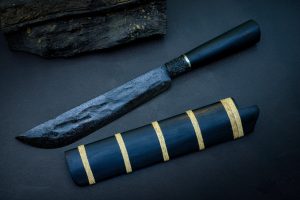Custom knife-making is an art that blends creativity, technical skill, and precision. Every knife tells a story, from the initial concept to the final polished blade. Designing a custom knife allows craftsmen and enthusiasts to create a tool that is both functional and personal, reflecting the intended use, aesthetic preferences, and the individuality of the maker.
Conceptualizing the Knife
Every custom knife begins with an idea. The design process starts by defining the knife’s purpose: will it be a chef’s knife, a hunting blade, a survival tool, or a collectible piece? Understanding the intended function helps determine the size, shape, weight, and materials used.
Sketching and planning are essential steps. Detailed drawings help visualize proportions, handle ergonomics, blade length, and edge geometry. This stage also allows exploration of decorative elements such as patterns, textures, engravings, or inlays. Conceptualization ensures that both form and function are considered before any material is worked.
Selecting Materials
Material choice is crucial in custom knife-making. Blade steel determines edge retention, flexibility, and durability, while handle materials influence grip, comfort, and aesthetics. Popular blade steels include high-carbon, stainless, and tool steels, each offering distinct characteristics suitable for different purposes.
Handle materials vary from traditional wood and horn to modern synthetics like G10, Micarta, and carbon fiber. Each material provides unique texture, weight, and visual appeal. Selecting complementary materials for both blade and handle enhances functionality and artistic coherence.
Forging and Shaping the Blade
Once materials are selected, the blade takes shape through forging or stock removal. Forging involves heating the steel and hammering it into form, creating strength and character in the metal. Stock removal entails cutting and grinding the steel from a billet to achieve precise geometry.
Shaping the blade requires attention to balance and edge geometry. Symmetry is essential for both performance and visual appeal. During this stage, makers refine bevels, taper the edge, and adjust thickness to suit the intended use. The process demands patience and careful measurement to ensure the blade meets functional and aesthetic standards.
Heat Treatment and Hardening
Heat treatment transforms steel into a functional blade, balancing hardness, flexibility, and toughness. Proper heating, quenching, and tempering processes create a durable edge capable of withstanding repeated use.
Understanding the specific requirements of the chosen steel is crucial. High-carbon steels often need careful quenching to prevent warping, while stainless steels require precise temperature control to optimize performance. Heat treatment turns a shaped blade into a reliable tool capable of retaining sharpness under stress.
Handle Construction and Assembly
The handle is more than a grip; it defines comfort, control, and the knife’s overall personality. Ergonomic shaping ensures the knife fits naturally in the hand, reducing fatigue and improving precision. Decorative elements, such as inlays, pins, or carvings, add individuality without compromising usability.
Attaching the handle involves careful alignment and secure fastening. Adhesives, pins, or rivets are used depending on the design, ensuring durability and stability. Once assembled, the handle is shaped, sanded, and finished to achieve a smooth, tactile surface that complements the blade.
Finishing Touches
Finishing the knife involves refining the edge, polishing the blade, and applying protective coatings if necessary. The final polish enhances aesthetics, highlights steel patterns, and ensures corrosion resistance. Edge sharpening creates the functional precision necessary for the knife’s intended tasks.
Decorative touches, such as engraving, etching, or patinas, can further personalize the knife, transforming it from a functional tool into a piece of art. The finishing process reflects the maker’s attention to detail and commitment to excellence.
Testing and Refinement
A completed knife is not finished until it is tested. Cutting, slicing, and practical use reveal how the design performs in real-world scenarios. Feedback from testing informs minor adjustments in edge geometry, balance, or handle comfort.
This iterative process ensures that the knife meets both practical and aesthetic expectations. A successful custom knife combines precision, durability, and beauty, providing a unique experience for the maker and user alike.
Personalization and Storytelling
Custom knives are more than tools—they are expressions of personality and craftsmanship. Each element, from steel choice to handle design, reflects a story and purpose. Makers often create knives that commemorate achievements, milestones, or personal interests, imbuing functional objects with emotional and artistic value.
Custom knife-making blends art, science, and technique. From the first concept sketch to the final polished blade, every step requires careful planning, skilled execution, and creative vision. The result is a knife that is not only functional and durable but also a unique reflection of the maker’s artistry and intent.




